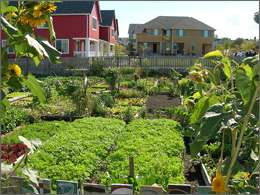Strategy of the Month: Creating Green Affordable HousingAugust 2010 Integrating green building practices in the development of affordable housing creates long-term energy cost savings, lower operating costs over the lifetime of the building, and a healthier home environment for low- and moderate-income residents. As local governments weigh the benefits of green building against its challenges, including the possibility of higher upfront costs and the learning curve associated with green industry codes and definitions, the National League of Cities (NLC) has developed a publication, Creating Green Affordable Housing, to guide municipal action.
The Creating Green Affordable Housing guide offers a list of resources for municipalities interested in developing their own successful green projects, from federal government programs that provide funding for green retrofitting or weatherization projects, to national organizations that provide education and advocacy information. Each highlighted project is accompanied by specific contact information for those that would like to learn more. To view the report in its entirety, please visit https://www.huduser.gov/portal/rbcrecord&DocId=2041. We hope this information will assist communities as they continue to look for ways to green affordable housing. If you have successfully implemented regulatory reform measures, would like to share resources, or require assistance in identifying additional policy tools, research, or strategies available through our searchable online Clearinghouse database, email us at rbcsubmit@huduser.gov, or call us at 1-800-245-2691 (option 4), or visit our website at www.regbarriers.org. Please consider forwarding this message to friends and colleagues with an interest in green affordable housing. |

|
|
|
 The action guide outlines steps and strategies for the creation of green affordable housing, including education and advocacy, to inform residents and stakeholders of the benefits of green choices. Municipalities are also encouraged to revisit their general plan, land use ordinances, and zone regulations to implement more green building alternatives and incentives such as fee waivers or expedited reviews. The report highlights successful green affordable housing projects and policies across the country, as in the green building policy of San José, California that incorporates mandatory green building standards for residential development. Several of the projects highlighted by the guide were the results of successful public-private partnerships, a strategy that NLC promotes to gain project guidance and support, along with financing opportunities. A green project in Seattle, Washington increased one neighborhood's supply of low-income housing by 43 percent. At the same time, the green building methods used are expected to reduce the development's total consumption of water, electricity, and natural gas by more than half.
The action guide outlines steps and strategies for the creation of green affordable housing, including education and advocacy, to inform residents and stakeholders of the benefits of green choices. Municipalities are also encouraged to revisit their general plan, land use ordinances, and zone regulations to implement more green building alternatives and incentives such as fee waivers or expedited reviews. The report highlights successful green affordable housing projects and policies across the country, as in the green building policy of San José, California that incorporates mandatory green building standards for residential development. Several of the projects highlighted by the guide were the results of successful public-private partnerships, a strategy that NLC promotes to gain project guidance and support, along with financing opportunities. A green project in Seattle, Washington increased one neighborhood's supply of low-income housing by 43 percent. At the same time, the green building methods used are expected to reduce the development's total consumption of water, electricity, and natural gas by more than half. 
